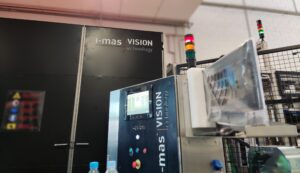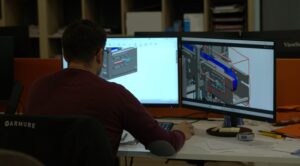In a context where efficiency, quality and scalability are key, machine vision and artificial intelligence (AI) technologies are redefining the way the industry approaches its processes.
At I-MAS, we have been working in industrial automation for more than 20 years and today more than ever these tools are an essential part of our approach.
Listen before automating
One of the most important factors in industrial automation is a thorough understanding of the real needs of each company. It is not just a matter of meeting technical specifications, but of understanding the operational context, available resources and specific production objectives. By actively listening to the customer, it is possible to develop solutions that respond exactly to the challenges faced by production plants.
Two major challenges: quality and efficiency in industrial automation
Currently, the main demands of industrial companies are focused on two main areas:
- Quality and process control: defect identification, visual inspection, traceability, automated sorting, etc.
- Automation of low value-added tasks: repetitive, labor-intensive processes that are difficult to cover due to lack of personnel or high costs.
Machine vision and AI can effectively address both issues, providing robust, scalable solutions with a direct impact on productivity.
Artificial intelligence and deep learning in real applications
Although AI is not yet widespread as an integral management system in factories, it is very present in specific high-value applications. Most advanced machine vision solutions already integrate deep learning models, either as the main system or as a complement to classic algorithms. This makes it possible to make decisions in real time with greater precision, reducing errors and increasing system reliability.
Featured case at i-mas: 360º vision, X-rays, deep learning and AI
One of the most innovative developments implemented recently has been a natural product selection line that combines:
- Visión artificial 360º para detectar defectos externos.
- X-rays to locate non-visible internal defects.
- AI and deep learning to make automatic decisions in less than 30 milliseconds.
The result is a unique system that enables previously impossible levels of inspection with exceptional speed and reliability.
The role of robotics and intelligent automation toward 2030
The trend for the coming years is clear: an increase in automation with industrial and collaborative robots, a massive use of machine vision as a decision support system and major advances in hardware and software that will enable more versatile solutions.
These technologies will cease to be perceived as an expense and become key investments with a direct impact on profitability and corporate EBITDA.
Machine vision and artificial intelligence are transforming the way we think about industrial automation. At I-MAS, we will continue to focus on these technologies as a central part of our strategy to help companies compete with greater agility, quality and sustainability.
In the engineering department of I-MAS we apply methodologies based on more than 20 years of experience in industrial automation and machine vision, integrating Deep Learning models in different industrial processes. This approach allows transforming advanced technologies into applied solutions, improving productivity, reducing errors and optimizing traceability and plant control.
Want to learn more about our services? Contact us or visit our projects section!



